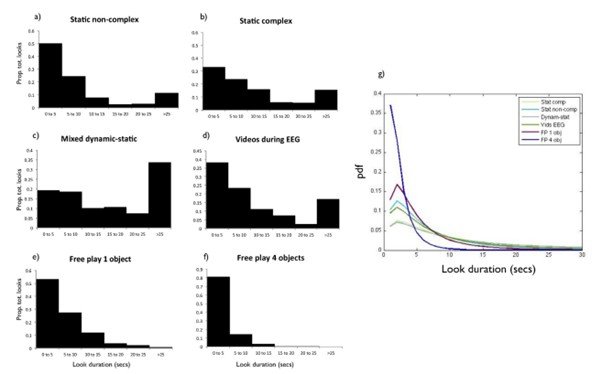RESEARCH
PUBLICATIONS
Search by keyword:
Browse by topic:
Finding order in chaos: influences of environmental complexity and predictability on development
Lancaster, K. L., & Wass, S. V. (2024). Finding order in chaos: influences of environmental complexity and predictability on development. Trends in Cognitive Sciences. https://doi.org/10.1016/j.tics.2024.11.012
Learning to imitate facial expressions through sound
Viswanathan, N. K., C.J.M, C., Wass, S. V., & Goupil, L. (2024). Learning to imitate facial expressions through sound. Developmental Review, 73. https://doi.org/10.1016/j.dr.2024.101137
Examining speech-brain tracking during early bidirectional, free-flowing caregiver-infant interactions
Phillips, E.A.M., Goupil, L., Ives, J.E., Labendzki, P., Whitehorn, M., Marriott Haresign, I. and Wass, S.V. (2024). Examining speech-brain tracking during early bidirectional, free-flowing caregiver-infant interactions. : https://doi.org/10.1101/2024.05.16.594544
Download PDF | Access Paper
Why behaviour matters: Studying inter-brain coordination during child-caregiver interaction
Marriot Haresign, I., Phillips, E. A. M., & Wass, S. V. (2024). Why behaviour matters: Studying inter-brain coordination during child-caregiver interaction. Developmental Cognitive Neuroscience, 67. https://doi.org/10.1016/j.dcn.2024.101384
The neural and physiological substrates of real-world attention change across development.
Perapoch Amadó, M., Greenwood, E., Ives, J., Labendzki, P., Marriott Haresign, I., Northrop, T. J., Phillips, E. A. M., Viswanathan, N. K., Whitehorn, M., Jones, E. J. H., & Wass, S. V. (2023). The neural and physiological substrates of real-world attention change across development. Elife. https://doi.org/10.7554/elife.92171.2
Sing to me, baby: Infants show neural tracking and rhythmic movements to live and dynamic maternal singing.
Nguyen, T., Reisner, S., Lueger, A., Wass, S. V., Hoehl, S., & Markova, G. (2023). Sing to me, baby: Infants show neural tracking and rhythmic movements to live and dynamic maternal singing. Developmental Cognitive Neuroscience. https://doi.org/10.1016/j.dcn.2023.101313
The development of the relationship between auditory and visual neural sensitivity and autonomic arousal from 6m to 12m.
Daubney, K., Suata, Z., Marriott Haresign, I., Thomas, M., Kushnerenko, E., & Wass, S. V. (2023). The development of the relationship between auditory and visual neural sensitivity and autonomic arousal from 6m to 12m. Developmental Cognitive Neuroscience. https://doi.org/10.1016/j.dcn.2023.101289
Comparing methods for measuring peak look duration: are individual differences observed on screen-based tasks also found in more ecologically valid contexts?
Wass, S.V. (2014). Comparing methods for measuring peak look duration: are individual differences observed on screen-based tasks also found in more ecologically valid contexts? Infant Behavior and Development. 37(3), 315-325. https://doi.org/10.1016/j.infbeh.2014.04.007
Visual motherese? Signal-to-noise ratios in toddler-directed television.
Wass, S.V. & Smith, T.J. (2014). Visual motherese? Signal-to-noise ratios in toddler-directed television. Developmental Science. 18(1), 24-37. https://doi.org/10.1111/desc.12156
Applying cognitive training to target executive functions during early development.
Wass, S.V. (2014). Applying cognitive training to target executive functions during early development. Child Neuropsychology. 21 (2), 150-166. https://doi.org/10.1080/09297049.2014.882888
The uses of cognitive training technologies in the treatment of Autism Spectrum Disorders.
Wass, S.V. & Porayska-Pomsta, K. (2013). The uses of cognitive training technologies in the treatment of Autism Spectrum Disorders. Autism 18(3), 1-21. https://doi.org/10.1177/1362361313499827
Training attentional control and working memory – is younger, better?
Wass, S.V., Scerif, G. & Johnson, M.H. (2012). Training attentional control and working memory – is younger, better? Developmental Review 32 (4), 360–387. https://doi.org/10.1016/j.dr.2012.07.001
Parsing eyetracking data to provide accurate fixation duration estimates in infants and adults.
Wass, S.V., Smith, T.J. & Johnson, M.H. (2012). Parsing eyetracking data to provide accurate fixation duration estimates in infants and adults. Behavior Research Methods. https://doi.org/10.3758/s13428-012-0245-6
Training attentional control in infancy.
Wass, S.V., Porayska-Pomsta, K. & Johnson, M.H. (2011). Training attentional control in infancy. Current Biology 21(18), 1543-1547. https://doi.org/10.1016/j.cub.2011.08.004
Developing technology for autism, an interdisciplinary approach.
Porayksa-Pomsta, K., Frauenberger, C., Wass, S.V. et al. (2011). Developing technology for autism, an interdisciplinary approach. Personal and Ubiquitous Computing 16 (2), 117-127. https://doi.org/10.1007/s00779-011-0384-2
Distortions and disconnections: disrupted brain connectivity in autism.
Wass, S.V. (2011). Distortions and disconnections: disrupted brain connectivity in autism. Brain and Cognition 75(1), 18-28. https://doi.org/10.1016/j.bandc.2010.10.005















